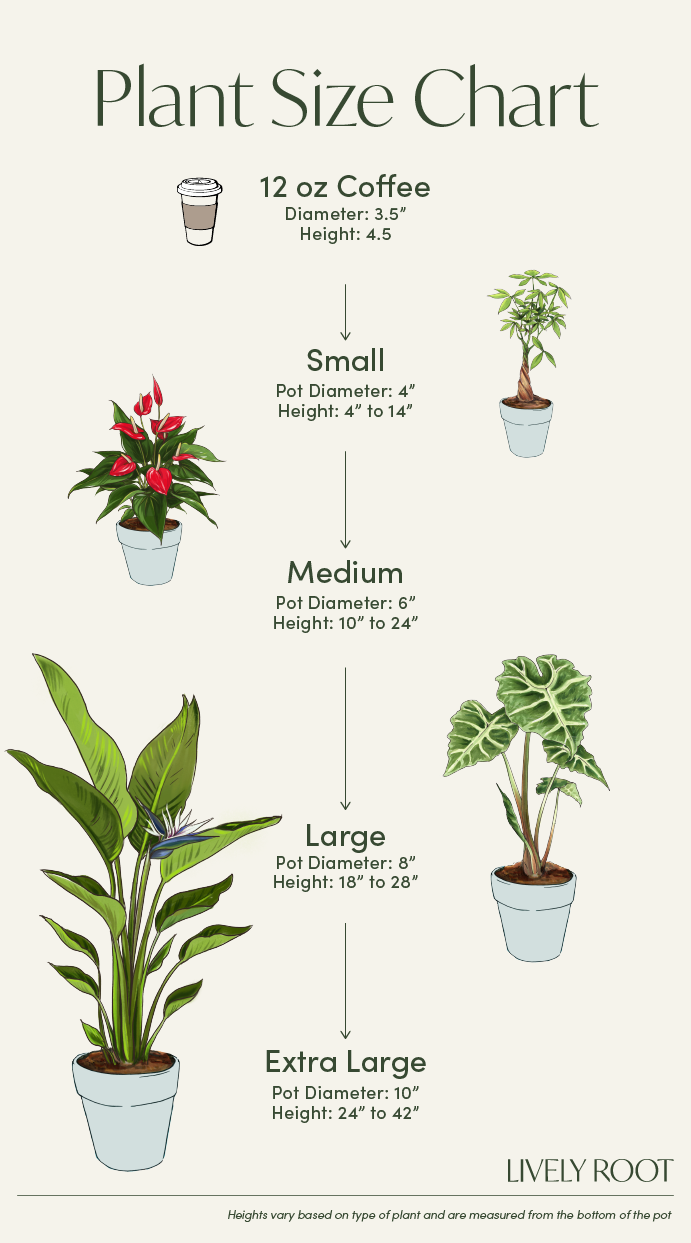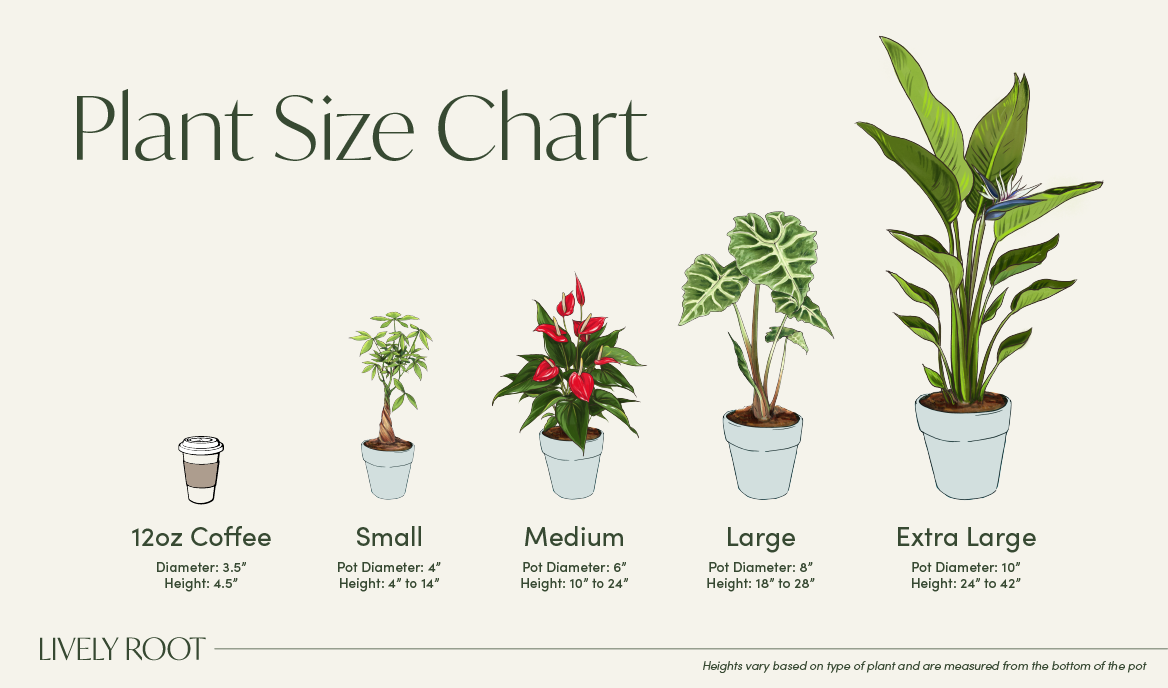

Our Norfolk Pine (Araucaria heterophylla) is a party waiting to happen! He's ready for all manner of decoration and costume. His upright trunk sits erect with his pyramidal shape. His evergreen form holds whorled, parallel branches (typically 5 branches per whorl) in layers. He will do double-duty for the sights of the season as well as a great houseplant throughout the year growing up to 3-5' over time!
Araucaria heterophylla Care Guide

Rotate your Norfolk plant in front of a bright, direct light window for all sides to get enough light for photosynthesis.
Keep consistently moist during the spring and summer. Let the soil dry a bit more in the winter months but still stay consistently lightly moist. If the needles turn yellow and drop, check the soil's moisture and humidity levels.
Your Norfolk pine will need an average of 50% humidity to keep him comfortable.
Keep this plant in cooler temperatures with lots of moisture in the air to imitate their natural environment.
This little guy doesn't like to get his toes or needles cold. Bring him in when temps are hitting 50°F or below.
Apply a balanced fertilizer at half-strength every other month in the growing season.
When receiving the Norfolk Pine, do not repot immediately but wait at least 6-12 months or if the roots are beginning to get crowded and growing through the drainage holes. Repot this little guy in the spring, using a 2 inches bigger pot to keep the roots drier. (Too big of a planter could cause the soil to dry slower.) Place a piece of screening at the bottom of the container over the drainage hole to secure the soil and allow to drain. Fill in around your container and the bottom with equal parts of sterilized potting soil, coconut coir, and sand or perlite, with one tablespoon of bone meal to encourage root growth. Water your plant in the old pot before transferring over and let sit overnight. Add well-draining interior potting soil to the bottom to elevate the root ball. Lift the plant and release the roots against the existing planter. Use a clean knife or garden trowel to wedge between the pot and the soil to loosen. Inspect the root ball. Notice if there are any dead or rotting roots and trim them off with sterile pruners. Ensure the plant is sitting about 1 inch below the edge of the pot to avoid water spillage. Add more soil and backfill around the sides by tamping down. Fill up to the soil line but not over. Do not water again until the soil is registering three on the plant meter. If soil settling occurs after watering, add more periodically but do not cover the trunk above the surface.
Remove any dead, damaged, or diseased limbs, but this little guy is low maintenance and usually won't need any pruning.
In early autumn, collect the cones that fall from this little guy. Break apart the cone and gather the seeds, and plant quickly. Use equal parts of loam, sand, and coco coir. Plant the pointed end down at a 45° angle with a bit of the rounded end visible above the soil. Keep the soil consistently damp and sit and watch. Please keet in bright, indirect light. Viable seeds should sprout within two weeks. As they grow, continue to rotate your planter (with drainage) to get the benefits of light from all sides.
Norfolk Pine Care & Buying Guide
Norfolk Island Pine For Sale: Overview
The Norfolk Island Pine (Araucaria heterophylla) is a beautiful evergreen conifer with an upright trunk and delicate, feathery needles on horizontal branches forming a neat, pyramidal shape. It can be the perfect potted Christmas tree for the holiday season, with the added benefit of adapting to warmer indoor conditions.
Not a true pine, this beautiful pine-like tree belongs to the Araucariaceae family, which has some of the most ancient plant species on earth among its members. Native to Chile and Norfolk Island in the South Pacific Ocean, the Norfolk Pine has traditionally been used for timber, furniture making, and shipbuilding.
This beautiful plant can grow outdoors in USDA hardiness zones 10-11 but must be brought indoors if the temperatures fall below 50°F. A mature indoor Norfolk Pine will grow up to around 5-6 ft tall, and will not exceed 8 ft. This charming tree is relatively easy to care for and it symbolizes abundance, growth, and balance. Unfortunately, the Norfolk Island Pine is mildly toxic to cats and dogs if ingested, which makes it not entirely pet-friendly.
For even more gorgeous and festive decoration ideas, check out our fresh-cut Holiday Wreath and aromatic Cedar Garland. In addition, you may want to consider getting a 4-pack Mini Norfolk Pine Trees to share with friends and family.
Norfolk Island Pine: Benefits
- Purifies the air from toxins
- Excellent festive decor for the holidays
- Easy to care for
- With a delicate pine scent
- Beautiful live Christmas tree that you can enjoy for many holiday seasons
Araucaria Heterophylla: Common Names
- Australian Pine
- Living Christmas Tree
- House Pine
- Star Pine
- Polynesian Pine
Norfolk Island Pine: Care Guide
This beautiful Christmas tree is an easy-care plant that can thrive in average home conditions. Here are our tips on how to care for a Norfolk Pine:
Watering and Humidity
Good Norfolk Island Pine care starts with watering your tree properly. The Norfolk Island Pine requires slightly moist soil to thrive. Don’t overwater, but check that the soil doesn’t get too dry, especially if you notice the needles turning yellow. As a tropical plant, the Norfolk Island Pine needs higher indoor humidity (about 50%). You can place its pot on a pebble tray or mist occasionally to keep humidity high.
Light and Temperature
The Norfolk Pine light requirements are bright, direct light. For the best Araucaria heterophylla care, provide your plant with a sunny place near the window. Remember to rotate the plant for even light exposure. The ideal Norfolk Pine temperature range is 55℉ to 65℉. Bring your Norfolk Pine indoors when the temperatures are lower than 50°F.
Soil and Repotting
Your Norfolk Island Christmas tree will grow best in soil that drains well but retains moisture. The best Norfolk pine soil is a well-draining potting mix with added perlite, sand, and coconut coir. After receiving your Norfolk Pine for sale, you don’t need to repot it right away. Repot your Norfolk Island Pine tree once every three years, into a pot about 2 inches larger than the previous one.
Feeding and Propagation
Feed your Norfolk Christmas tree monthly with a balanced fertilizer diluted to half-strength. For Norfolk Pine propagation, gather a cone and break it apart to remove the seeds. Then plant these in a well-draining, loamy soil. When the seeds sprout, keep them in bright, indirect light and rotate for the new plant to receive light from all sides, encouraging even growth.
Pruning and Common Issues
Pruning isn’t normally necessary for this indoor tree. Trim off any damaged or dead branches to keep your Norfolk Island Pine Christmas tree neat.
Branches drying out is one of the common Norfolk Pine problems caused by underwatering. Keep your tree hydrated with regular watering so that the soil stays slightly moist but not soggy. Dry air can cause the needles of your Norfolk Pine houseplant to drop, so provide your plant with high humidity.
Norfolk Island Pine Christmas Tree: Placement, Companion & Alternative Plants
An Araucaria heterophylla Norfolk Island Pine makes a delightful statement plant, especially during the holidays when it can be decorated with lights and ornaments.
Best Locations & Uses
- Beautiful centerpiece plant in the living room
- Great balcony or porch plant for the holiday season in warmer climates
- Wonderful gift plant
- Perfect for well-lit and humid spaces
- Ideal alternative to a fresh-cut Christmas tree as it doesn’t shed its needles indoors
Companion Plants
To decorate your living space this holiday season, combine the Norfolk Pine Tree with other gorgeous holiday plants:
- Red Christmas Cactus (Schlumbergera bridgesii): The beautiful Red Christmas Cactus is a tropical epiphyte that thrives in higher humidity and bright light, producing showy red and white blooms.
- Aglaonema Red Siam (Aglaonema commutatum ‘Red Siam’): An easy-care exotic beauty, the Aglaonema Red Siam sports beautiful, multicolored foliage and grows best in well-lit spaces.
- Baby Blue Eucalyptus (Eucalyptus pulverulenta ‘Baby Blue’): With its adorable, round blue-green foliage, the Baby Blue Eucalyptus is prized as a decorative plant for floral displays.
Alternative Plants
If you’re not sure about growing a Norfolk Pine tree in your indoor space but would like a festive centerpiece, check out these amazing alternatives:
- Leyland Cypress Christmas Tree (Cuprocyparis leylandii): The beautiful Leyland Cypress Christmas Tree is a charming alternative to Norfolk Pine, which also thrives in full sun.
- Rosemary Christmas Tree (Rosmarinus officinalis): With its amazing scent and beautiful needle-like leaves, the Rosemary Christmas Tree is a beautiful festive decoration for smaller spaces and a wonderful culinary herb.
- Lavender Topiary (Lavandula stoechas 'Primavera'): For an unusual holiday centerpiece, get an elegant Lavender Topiary and decorate this lovely potted herb with beautiful Holiday Lights for Plants.
Order Your Norfolk Pine for Sale This Christmas From Lively Root
Make your holidays merry and bright with a beautiful Norfolk Island Pine for sale from Lively Root! We offer different sizes to suit your needs!
























































